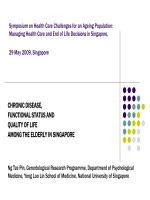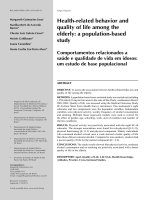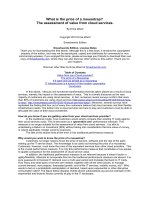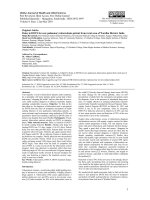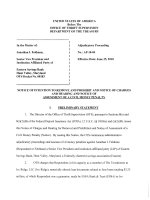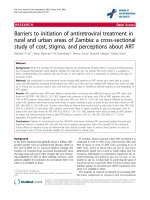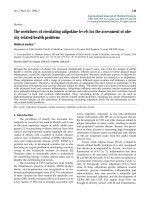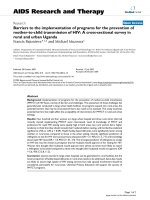Assessment of Quality of Life among Rural and Urban Elderly Population of Wardha District, Maharashtra, India pptx
Bạn đang xem bản rút gọn của tài liệu. Xem và tải ngay bản đầy đủ của tài liệu tại đây (29.31 KB, 5 trang )
Assessment of Quality of Life among Rural and Urban Elderly
Population of Wardha District, Maharashtra, India
Abhay Mudey
1
, Shrikant Ambekar
2
, Ramchandra C. Goyal
3
,
Sushil Agarekar
4
and
Vasant V Wagh
5
Department of Community Medicine, Jawaharlal Nehru Medical College, Sawangi (M),
Wardha, Maharashtra, India
1
Telephone: 91-9373187088, E-mail:
1
<>,
2
<>,
3
< >,
4
<>,
5
< >
KEYWORDS Elderly. Quality of Life. Ageing. Domains of QOL. Geriatric Care
ABSTRACT All aspects of health status: life style, satisfaction, mental state or well-being together reflect the
multidimensional nature of Quality of Life (QOL) in an individual. India has acquired the label of “an aging nation”
with 7.7 percent of its population being more than 60 years old. Changes in population structure will have several
implications for health, economic security, family life and well being of people. The present study was carried out
with two-fold objectives to assess the difference of quality of life between rural and urban elderly population and to
find out the association between the socio-demographic profile and quality of life of elderly population. The
community based cross sectional study was conducted on 800 elderly subjects selected from urban (n= 400) and rural
(n= 400) using multistage simple random technique. Interviews were conducted using pre-tested questionnaire by
trained interviewers to collect data. The WHO-QOL BREF was used to assess the quality of life. The study showed
that the elders living in the urban community reported significant lower level of quality of life in the domains of
physical 51.2±3.6 and psychological 51.3±2.5 than the rural elderly populations. The rural elderly population
reported significant lower level of quality of life in the domain of social relation 55.9±2.7 and environmental
57.1±3.2 than urban population. The difference between the quality of life in rural and urban elderly population is
due to the difference in the socio-demographic factors, social resource, lifestyle behaviors and income adequacy.
Corresponding author:
Dr. Abhay Bhausaheb Mudey
Professor,
Department of Community Medicine,
Jawaharlal Nehru Medical College,
Sawangi (M), Wardha,
Maharashtra, India
Telephone: 91-9373187088,
E-mail:
INTRODUCTION
Ageing is a normal, biological and universal
phenomenon. Ageing of the population is
occurring throughout the world, more rapidly in
developing countries. United Nations considered
60 years to be dividing line between ‘old age’
and ‘middle and younger age group’.threshold
of old age (Meisheri 1992). In most of the
gerontological literature, people above 60 years
of age are considered as ‘old’ and constituting
the ‘elderly’ segment of the population (Prakash
1999).
In India proportion of older persons has risen
5.5 percent in 1951 to 6.5 percent in 1991, 7.7 in
2001 and projected 12 percent in 2025 (Vinod
Kumar 2003). Changes in population structure
will have several implications on health, economy,
sec-urity, family life, well-being and Quality of
Life of people.
All the aspects of “Health status”, “Life-
style”, “Life satisfaction”, “Mental health” and
“Well-being” together reflects the multidimen-
sional nature of Quality of Life in an individual
(Barua 2007). Quality of life is a holistic approach
that not only emphasizes on individuals’
physical, psychological, and spiritual function-
ing but also their connections with their
environments; and opportunities for maintain-
ing and enhancing skills. Ageing, along with the
functional decline, economic dependence, and
social cut off, autonomy of young generation,
compromises quality of life. The dilemma of
dichotomy of longetivity on one hand and
enormously compromised QOL is indeed per-
plexing. Reluctance in caring of elderly and con-
cept of QOL is not yet popular in India. Study
done by Verma (2008) shows that total QOL in
urban area is significantly better than rural. But
as per our assumption, in rural areas, the elderly
work till their body permits they experience power,
prestige in family and social life and economic
© Kamla-Raj 2011 Ethno Med, 5(2): 89-93 (2011)
independence while in urban areas, the elderly
work for certain age limit as per their jobs, after
which they suffer from economic insecurity, loss
of power leading to low quality of life. So, we
are trying to explore the domain in which rural –
urban population are lacking and recommend the
measures to improve the quality of life.
Objectives
· To assess the difference in Quality of Life
between rural and urban slum elderly population
in study district.
· To find out the association between the socio-
demographic factors and Quality of Life of
elderly population in study district.
MATERIAL AND METHODS
Study Setting: The study was conducted in
rural and urban slum areas of Wardha district
which include eight villages under Primary Health
Center in Seloo block and eight urban slum areas
of Wardha city which is located in Maharashtra,
India.
Reference Population: Elderly population of
age 60 years and above of Wardha district
Study Participants: Four hundred individu-
als aged 60 years and above selected each from
rural area of Seloo block and urban slum area of
Wardha city in Wardha district of Maharashtra,
India
Study Design and Sampling: A community
based cross-sectional study was conducted and
participants were selected using multistage
simple random sampling technique.
Inclusion Criteria: People of age 60 years
and above and willing to participate in the study
with written consent
Exclusion Criteria: Those who were
unwilling to participate in the study, refused to
give written consent and people unable to give
interview due to various morbidity conditions
Strategy: The study was conducted during
January 2008 to December 2008. Data was
collected using WHOQOL BREF scale (Field trial,
WHO 1996) after obtaining the permission from
the Institutions Ethics Committee. The partici-
pants were interviewed at their homes after tak-
ing a written consent in local language. Informa-
tion was collected on socio-demographic factors
and four domains, that is, physical, psychologi-
cal, social relationship and environmental.
For comprehensive assessment, one item from
each of 24 facets contained in the WHOQOL-100
had been included; in addition two items from
the QOL and general health facets were also
included. Each item was rated on five point scale
(1-5). The raw score of each domain was calcu-
lated, and then transferred into range between
0-100. Five percent of questionnaires were re-
checked by another author to assess the quality
of data.
Statistical Analysis: The data were tabulated
and analyzed using the statistical package of
SPSS 13.0 version. Proportion test was used to
test the significant at P<0.05 and P<0.01
RESULTS
Among 400 rural participants, 44 percent were
males and 56 percent females as compared to 41
percent males and 59 percent females in urban
slums. The proportion of rural elderly in the age
group 60-69 years was 45.5percent and urban
slum elderly in the age of 70-79 was 42.2 percent
(Table 1).
The mean age of study participants was 68.84
±7.06 years, of which females were 71.81 ± 7.49
years, which was higher than that of the males at
68.29 ± 6.31 years. Majority of the rural partici-
pants 74.75 percent were illiterate as compared
to urban slum participants (49 percent).
In the urban male, psychological domain
was 51.14 ±6.69 as compared to 51.59 ± 7.27 in
urban female. This difference in psychological
domain was found to be statistically significant
(P<0.001). However, no statistically significant
difference was found in psychological domain
between the rural male and female. The score for
environmental domain was 58.52 ± 7.97 in rural
male as compared to 56.13 ± 7.64 in rural female.
The association between environmental domain
and sex was found to be statistically significant
at P< 0.001 amongst the rural population.
The physical domain score was 61.95 ± 10.72
amongst 60-69 years as compared to 55.18 ± 9.71
amongst geriatric above 70 years in rural areas.
The psychological domain score amongst rural
elderly between 60-69 years was 55.08 ± 8.48 as
compared to 50.78 ± 7.26 in those above 70 years
of age. The difference in physical and psycho-
logical domain scores amongst rural population
with respect to age was statistically significant.
No significant difference was found for urban
slum population (Fig. 1).
ABHAY MUDEY, SHRIKANT AMBEKAR, RAMCHANDRA C. GOYAL ET AL.
90
Sex
Male 58.07 50.97 52.19 51.14 55.95 59.39 58.52 60.28
(10.13) (7.08) (8.18) (6.99) (7.56) (7.46) (7.97) (7.51)
Female 58.42 51.55 53.17 51.59 55.86 59.44 56.13 59.57
(11.45) (7.23) (8.02) (7.27) (7.38) (5.74) (7.64) (7.98)
P value 0.74 0.41 0.22 0.001* 0.60 0.95 0.00** 0.36
Age
60-69 61.95 51.34 55.08 52.29 55.7 59.21 57.32 60.32
(10.72) (7.11) (8.48) (7.21) (7.67) (6.11) (8.16) (8.09)
> 70 55.18 51.2 50.78 50.95 56.07 59.5 57.07 59.79
(9.71) (7.17) (7.26) (7.04) (7.31) (6.96) (7.70) (7.56)
P value 0.00** 0.85 0.00** 0.085 0.661 0.66 0.764 0.54
Marital Status
Single 59.35 51.65 52.11 51.61 55.8 59.98 56.8 60.04
(10.78) (7.54) (8.42) (7.23) (7.60) (7.29) (7.78) (7.96)
Married 57.63 50.8 53.81 51.06 55.96 58.8 57.41 59.84
(10.55) (6.68) (7.89) (6.99) (7.27) (5.97) (8.14) (7.50)
P value 0.11 0.13 0.013* 0.4 0.85 0.09 0.45 0.8
Education
Illiterate 57.01 51.35 51.54 51.21 56.14 58.96 57.29 60.47
(9.69) (7.39) (7.08) (7.36) (7.34) (7.78) (7.65) (8.14)
Literate 61.98 51.11 56.29 51.51 55.21 59.95 56.86 59.34
(12.65) (6.87) (9.84) (6.83) (7.85) (5.14) (8.65) (7.20)
P value 0.00** 0.73 0.00** 0.67 0.24 0.129 0.657 0.155
Table 1: Association between socio-demographic factors and mean score of domains among the study
participants
Socio- Mean score of domain
demographic
factor
Rural Urban Rural Urban Rural Urban Rural Urban
* Significant at 5 % level (P<0.05),
** Significant at 1 % level (P<0.001)
Physical Psychological Social relationship Environmental
45
50
55
60
Physical
(P=0.01
*
)
Psycological
(P=0.01
*
)
Social relation
(P=0.001
**
)
Environmental
(P=0.001
**
)
Fig. 1. Comparison between the different domain score of quality of life among rural and urban slum
participants
*Figure in parenthesis indicates standard deviation
* Significant at P <0.05
** Significant at P <0.001
ASSESSMENT OF QUALITY OF LIFE AMONG RURAL AND URBAN ELDERLY POPULATION
91
Urban Rural
The scores for psychological domain amongst
married elderly population (53.82± 7.89) was
higher than single or widowed elder people (52.11
± 8.42) and was found to be statistically signifi-
cant.
The rural literate are higher (61.98 ± 12.65) as
compared to the illiterate rural in the physical
domain (57.01± 9.69). The scores for psycholo-
gical domain was also higher for rural literate
(56.29±9.84) as than to the illiterate population
from rural area in (52.54 ± 7.08). The differences
in the rural area with respect to educational
status was statistically significant for physical
and psychological domains (Table 1), whereas
such difference was not found among urban
population.
DISCUSSION
The proportion of rural elderly in the age
group 60-69 years was 45.5 percent , 70-79 years
was 39.3 percent and urban slum elderly in the
age of 70-79 was 42.2 percent. It shows that
longevity among urban slum is more than the
rural area. Studies conducted in rural southern
India showed that elderly population between
70-79 years ranged from 51.7 percent in Guntur
district to 39 percent in Villupuram district
(Venkateswarlu et al. 2003).
The mean age of the females was 71.81 ± 7.49
years, which is higher than that of the males at
68.29 ± 6.31 years.
Majority of the rural participants (74.75
percent) were illiterate as compared to urban slum
participants (49 percent). In a study conducted
in another rural area of Wardha by Kishore and
Garg (1977), the percentage of illiterates was
found to be 66.5 percent.
The elders living in the urban slum area have
significantly lower level of Quality of Life in the
domains of physical {51.2 . ±7.1)} score and
psychological {51.3 ±7.12} score than the rural
elderly populations. Rural elderly enjoy the power
and have positive feeling about future due to
traditional rituals. There are several studies show-
ing that retirement is closely related to poor health
(Batcheler and Nepier 1953; Johnson 1958). This
contradicts the study done by Verma (2008)
which says that rural elderly have more physical
problems. This is true due to lack of health facil-
ity, unawareness and poor diet but the QOL is
the subjective feeling of individual. Urban popu-
lations are aware of their disease condition and
are more concerned for health problems while in
rural area they just ignore it considering being
natural process. The rural elderly population
have a significant lower level of quality of life in
the domain of social relationship (55.9 ± 7.48)
score and environmental (57.1 ± 7.91) score.
Urban elderly are actively involved in some
groups that give them opportunity to socialize
themselves. Physical safety and security, home
environment, financial resources, health and
availability and quality of social care are very
high in urban areas. So they report high on envi-
ronment.
Rural areas showed statistical significant dif-
ference in physical and psychological domain
with respect to age. It showed that as the age
increases, the Quality of Life decreases in physi-
cal and psychological domain, which are similar
to the findings by Barua et al. (2007) which state
that age was significantly associated with phy-
sical, psychological and social domain. No sig-
nificant difference was found for urban slum
population.
The scores for psychological domain amongst
married elderly population was higher than single
or widowed elder people, and was found to be
statistically significant while Barau et al. (2007)
state that environmental and social domain is
significantly affected. In a cross-sectional study
in Kerala, the author Bhattathiri found that being
widowed or single was associated with poor
QOL (Bhattathiri 2007).
In rural area, the literate elderly people had
better Quality of Life as compared to illiterate
people, which was statistically significant for
physical and psychological domains. Bhatia et
al. (2007) conducted a study in 10 villages of
district Ludhiana, Punjab, reported that Quality
of Life was found to be significantly associated
with education while according to Barau et al.
(2007) it is not associated. Literates have better
understanding of their ageing process and
better accommodate to lifestyle changes. Aver-
age score for total Quality of Life in present study
is 55.85 similar to another study done in south
India (Varma et al. 2007) while in Canada the total
QOL score is 75 (Hopman et al. 2000). Functional
capacity, healthy active lifestyle, good housing,
social relationship along with economic status
affect the Quality of Life.
CONCLUSION
The Quality of Life of rural elderly population
was better in physical and psychological domains
ABHAY MUDEY, SHRIKANT AMBEKAR, RAMCHANDRA C. GOYAL ET AL.
92
whereas QOL in urban slum elderly was better in
social relationship and environmental domain.
This may be because of socio-demographic
factors, chronic diseases, social resources, life
style behaviors and financial resources
RECOMMENDATIONS
1. Periodic health check-ups should be orga-
nized for the elderly population so as to pro-
vide comprehensive health service through
available infrastructure. Medical officer at
PHC should be trained in geriatric.
2. Community health programmes like elderly
club, effective participation, rehabilitation
etc. to be organized for better care and sup-
port.
3. Integration through medicine and commu-
nity (family, care taker, voluntary organiza-
tions) for improving Quality of Life of el-
derly.
To improve the quality of life after the age 60,
efforts have to start at least from the age of 30.
Preventive maintenance is wiser and less expen-
sive than crisis management. Right mental
attitude and a sound physical health in adult life
and middle age period are the keys for enjoying
the active ageing.
ACKNOWLEDGEMENT
The authors are sincerely thankful to Dr.
Padma Shetty, Public Health Consultant/Adviser,
Prabhadevi, Mumbai and Dr. Meenakshi Khapre,
Asst. Prof., JNMC, Sawangi (M) Wardha for their
help in writing the article.
REFERENCES
Barua A, Mangesh R, Harsha Kumar HN, Mathew S
2007. A cross-sectional study on quality of life in
geriatric population. Indian J Community Med,
32(2): 146-147
Batchelor LRC, Napier MB 1953. Attempted suicide in
the old age. British Medical Journal, 2: 1196-
1190.
Bhatia SPL, Swami HM, Thakur JS, Bhatia V 2007. A
study of health problems and loneliness among
the elderly in Chandigarh. Indian J of Community
Medicine, 32(4):10-12.
Bhattathiri JJ 2008. Quality of life of geriatric population
in rural area, Thiruvaranthpuram city. A Paper
Presented at IASPMCON 2008, Puducherry.
Hopman WM Towheed T, Anastassiades T, Tenenhouse
A, Poliquin S, Berger C, Joseph L, Brown JP,
Murray TM, Adachi JD, Hanley DA 2000. Canadian
normative data for the SF-36 health survey.
Canadian Multicentre Osteoporosis Study Research
Group. CMAJ, 163(3): 265-71.
Johnson DE 1958. A depressive retirement syndrome.
Geriatrics 13: 314-319.
Kishore S, Garg BS 1997. Socio-medical problems of
aged population in rural area of Wardha district.
Indian Journal of Public Health, 41(2): 43-48.
Kumar Vinod 2003. Elderly in India — Needs and issues,
geriatric medicine in API textbook of medicine.
API, Mumbai pp. 1459-1462.
Meisheri YV 1992. Geriatric services—Need of the
hour. JPGM, 38(3): 103-105.
Prakash IJ 1999. Ageing in India. A Life Course
Perspective of Maintaining Independence in Older
Age. World Health Organisation. WHO /HSC/AHE/
99.2.URL />WHO_HSC_AHE_99.2_life.pdf (Retrieved on
March 6, 2009)
Saxena S, Chandiramani K, Bhargava R 1998.
WHOQOL-Hindi: A questionnaire for assessing
Quality of Life in health care settings in India.
Natl Med J India, 11(4): 160-165.
Varma GR , Kusuma YS and Babu BV 2007. Health-
related quality of life of elderly living in the rural
community and homes for the elderly in a district
of India, Application of the short form 36 (SF-
36) health survey questionnaire. Zeitschrift für
Gerontologie und Geriatrie, 43(4): 259-263.
Verma Sunil K 2008. Working and non-working rural
and urban elderly: Subjective well-being and quality
of life. Indian Journal of Gerontology, 22(1): 107-
118.
Venkateswarlu V, Iyer RSR, Rao KM 2003. Health Status
of the Rural Aged in Andhra Pradesh: A Sociological
Perspective. Research and Development Journal,
9(2). New Delhi: HelpAge India. URL – htpp://
harmonyindia.org/hdownloads/Monograph_
FINAL.pdf, (Retrieved March 6, 2009).
World Health Organization 1996. WHOQOL-BREF,
Introduction, administration, scoring and generic
version of assessment field trial version, December
1996. WHO/MSA/MNH/PSF/97.4, World Health
Organization, Geneva (Retrieved on March 2,
2009).
ASSESSMENT OF QUALITY OF LIFE AMONG RURAL AND URBAN ELDERLY POPULATION
93
